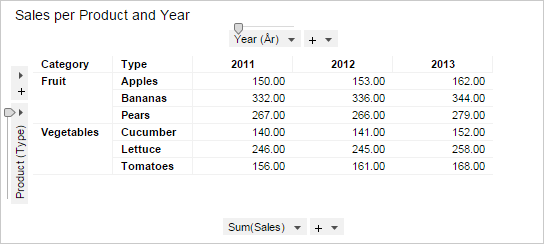
Home > Oracle Essbase > Spotfire for Oracle Smart View Users
If you are an Oracle Smart View user who is accustomed to do ad-hoc analysis, that is, if you are using Microsoft Excel spreadsheets with Smart View functionality for selecting members from a cube, there are a number of things you should think about when doing analysis in TIBCO Spotfire.
When doing ad-hoc analysis in Excel, you often start off with all dimensions as columns, and a single measure on the row. No data is shown until you explicitly refresh the spreadsheet. If you are familiar with your working cube, you might also be used to the free-form mode, where you type member names directly into the cells and thereby slice your cube. In Spotfire, there is no free-form mode editing.
Because Spotfire is interactive, you do not have to refresh your spreadsheet explicitly – the spreadsheet is automatically updated as you go.
The equivalent to the Excel spreadsheet in Spotfire is the cross table visualization. When you create a cross table visualization, Spotfire will suggest a measure as well as a dimension/hierarchy in the initial cross table. You should also see the Data panel, which shows you the available dimensions/hierarchies and measures (if the Data panel is not shown, click the Data button in the toolbar).
Cross table visualization in Spotfire.

Because there is no free-form mode editing in Spotfire, you should not start off by dragging all hierarchies to the visualization and go from there. Instead, you select what measures or accounts to show in the cells by selecting the appropriate measure in the lower horizontal axis selector in the cross table (or by dragging the appropriate measure from the Data panel to the axis selector). Also, in Spotfire, there is no explicit pivot operation. Instead, you select what dimension members to show on the vertical axis by selecting or dragging the dimension to the vertical axis selector. Similarly, you select which dimension members should be shown on the horizontal axis by selecting or dragging the dimension to the upper horizontal axis selector.
Note that you can have multiple dimensions on each axis. Those dimensions then become nested. Also note that multiple measures can be selected on the lower horizontal axis (value axis), but in that case "pivoting" is not possible.
In Spotfire, you slice your cube through filtering. That is, in the Data panel, you click on the filter icon next to the dimension you want to slice. This brings up an appropriate filter in which you select the member for that dimension. Repeat this for each dimension that should be sliced.

The best way to slice a hierarchy (to select a single member in a hierarchy filter) is to do the following:
Locate the member to slice by in the hierarchy filter by expanding the appropriate part of the hierarchy (click on the plus-signs before the parents to expand).
Right-click on the member to slice by and select Deselect Other Values from the pop-up menu.
Note: If you want to continuously see how the filters are defined, you can click on the Filter button on the toolbar. This brings up the Filters panel, in which all filters are displayed. You can modify the filter from within this panel, as well as from the Data panel. In the Data panel, you click on the filter icon next to the dimension you want to see or modify the filtering for to display the filter.
Often, the visualization will not show any data until all members to slice by have been specified (filtered) correctly. It is also common that query performance is bad until the cube has been sliced. Therefore, it might be better to define all the slicers before configuring the visualization correctly (by selecting the correct measures and dimensions on the axes).
See also:
Working with Data from Oracle Essbase
Minimizing the Strain on the Oracle Essbase Database